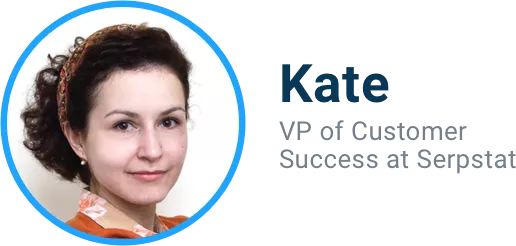A year ago, our friends at Serpstat approached us and asked us to help them build an academy for attracting potential users. At that point, we had built only one academy, but we enthusiastically agreed to help them.
I asked two members of Serpstat team to participate in writing this article: Igor from Marketing Team, and Kate from Customer Success. It was Igor who pushed for the creation of Serpstat academy, and Kate noticed some unexpected results.
How did this all get started?
We had a problem. We needed a tool we could use to present large amounts of content — content that would allow us to generate new leads. Usually, people use tools like whitepapers or ebooks for tasks like this, but I don’t like those options for several reasons:
- It’s difficult to create whitepapers and ebooks. Not only do you have to prepare the text and visual elements, but you also waste lots of time on layouts. What’s more, it’s really difficult to edit a whitepaper once it’s been finished.
- Whitepapers usually look like long PDF files. It’s a bit difficult to work with PDFs; there’s zero interactivity with them.
- It’s virtually impossible to get any information about which parts of a whitepaper are particularly interesting to readers. There’s also no way at all to find out which readers were active in the file and which just downloaded it. You don’t know anything about what readers did with the document after downloading it. Did they forward it to someone else? Did they read even half of it?
We saw an academy on one of our partner’s sites. There are large sections of content in the academy, which is divided into lessons and presented in a very user-friendly and interactive format. I quickly realized that we needed to create an academy just like this.
The process of creating an academy
I spent some time thinking about the topic for our first course. I understood that if we were to create a course called “How to use Serpstat,” it wouldn’t be interesting at all to people who had never heard of us before.
So I decided to create a course that covered general knowledge (about SEO and keywords), which would be useful and interesting to our target audience.
It’s easier to distribute this kind of course. After reading it, people want to know how to apply this knowledge (including with the help of Serpstat).
I created a course called “Basic Information About Keywords” and started promoting it as much as possible. We added a link to it to the footer on our site; talked about it in our newsletter and on social media; and wrote about it in our blog. This allowed users who already know our product to see our course, and it stimulated them to bolster their knowledge of the product and, as a result, purchase it.
After this, we began using guerilla marketing. I searched Quora for any questions relevant to the topic of our course, and I responded to them, including a link to Serpstat’s academy.
From there, users began visiting our academy, leaving their email addresses (users complete a simple registration upon entering the academy) and becoming warm leads after a couple lessons.
I know that some companies go as far as to pay for ads for their academy. We haven’t tried this method ourselves yet.
What we got out of one year of working with academies
- Our academy already has thirteen courses in two languages.
- More than 3,000 learners in the academy have turned into warm leads.
- About 5% of these people converted into paid users, without the participation of our Sales Team.
I especially like that academies are autonomous channels. You only have to spend time creating a course once and spread the word about it in order to generate leads in the future.
It’s also easy for us to scale this channel. We have been creating more and more new courses — for different levels of user expertise, different languages, etc.
Customer Success: An additional benefit beyond lead generation
As VP of Customer Success, I’m responsible for working with our current clients. It seemed to me that the academy Igor envisioned wouldn’t overlap much with my work. After all, it’s just a tool for lead generation.
Very quickly I found that we could create courses for different scenarios our current users find themselves in while using our product. For example, we could have a separate course for the newest users, or, conversely, for those well versed on the technical side.
We also began creating courses on our new features, which allowed users to master them more quickly. At the same time, we made courses on our underused features, which positively affected retention rate. It’s advantageous for us to have people utilizing as many features as possible.
Of course, we didn’t stop using other tools. For example, we keep our FAQ up, since a section of our users simply don’t need to go through a course — they just need to find the answer to a specific question that has arisen. We happily continue to answer our users’ questions in the Intercom chat. And, by the way, we hope that soon AcademyOcean will integrate their product with Intercom. : )
On the whole I can say that, for Serpstat, academies act as a tool that at once helps with the Marketing Team’s tasks and the Customer Success Team’s tasks.
Partnering with a specialized lead generation agency can further enhance your efforts to attract and convert leads effectively, ensuring sustained business growth and success.
What AcademyOcean is up to now
What exactly is AcademyOcean today?
- A constructor that allows you to create an academy out of an unlimited number of courses.
- An editor, where it’s easy both to create and change text and add images, videos, and other media.
- Automatically generated certificates for learners. You can select one of several templates and customize it to meet your needs. Certificates are one of the rewards for finishing a course. Learners can print them out or share them on social media, which serves as additional PR.
- Full statistics about each learner and each section of the content. Clients particularly like our course funnels.
- The ability to host an academy either on AcademyOcean’s domain or on any other domain or subdomain.
- The creation of closed academies (learners receive access only by invite).
- Individual profiles for each learner, which they receive in the academy after a very quick registration. Certificates and course progress are saved to learner profiles. Learners can also highlight the most important excerpts they find in the academy content and save them for future reference.
- Segmentation of courses into different categories of users. For example, different segments for different languages, markets, or user roles. These segments don’t overlap as they do, for example, in blogs or knowledge bases.
- Creation of quizzes, through which you can not only provide accredited certification but also ask your learners questions in the context of lessons. For example: “Which of the problems listed below is the most challenging for you?” or “Which products for solving this problem have you used in the past?”
- What’s very important to note is that to create an academy you don’t need any programming, design, or layout skills — none at all.
If the topic of user education is near and dear to you, as it is to us, and you would like to hear more from us, let’s be friends: https://www.facebook.com/academyocean/
In this blog, I share not only external but also internal news related to AcademyOcean: https://medium.com/@VladimirPolo
Talk to you later!
Related Articles
Display Advertising Effectiveness Analysis: A Comprehensive Approach to Measuring Its Impact
In this article, I will explain why you shouldn’t underestimate display advertising and how to analyze its impact using Google Analytics 4
Generative Engine Optimization: What Businesses Get From Ranking in SearchGPT
Companies that master SearchGPT SEO and generative engine optimization will capture high-intent traffic from users seeking direct, authoritative answers
From Generic to Iconic: 100 Statistics on Amazon Marketing for Fashion Brands
While traditional fashion retailers were still figuring out e-commerce, one company quietly revolutionized how U.S. consumers shop for everything from workout gear to wedding dresses






